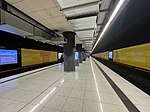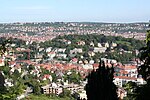Standseilbahn Stuttgart
Funicular railways in GermanyMetre gauge railways in GermanyRailway lines in Baden-WürttembergRailway lines opened in 1929Transport in Stuttgart

The Standseilbahn Stuttgart or Stuttgart Cable Car is a funicular railway in the city of Stuttgart, Germany. The line links the Südheimer Platz valley station with the Stuttgart Degerloch forest cemetery in the south quarters of Heslach. Operated by Stuttgarter Straßenbahnen AG (SSB), it was opened on 30 October 1929 to facilitate visitors to the forest cemetery which is located 90 metres (295 ft) above Stuttgart Heslach. At Südheimer Platz, the funicular connects to Stuttgart Stadtbahn lines U1 and U14.
Excerpt from the Wikipedia article Standseilbahn Stuttgart (License: CC BY-SA 3.0, Authors, Images).Standseilbahn Stuttgart
Böblinger Straße, Stuttgart Südheim (Stuttgart-Süd)
Geographical coordinates (GPS) Address Nearby Places Show on map
Geographical coordinates (GPS)
| Latitude | Longitude |
|---|---|
| N 48.755833333333 ° | E 9.1422222222222 ° |
Address
Talstation
Böblinger Straße 237
70199 Stuttgart, Südheim (Stuttgart-Süd)
Baden-Württemberg, Germany
Open on Google Maps







